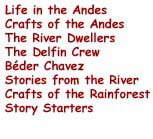|
Thursday, August 12, 1999
Early Morning Sun Rise
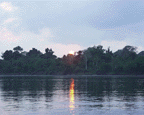 I
woke this morning at 5:00 am to watch the sun rise on the river and
do a little reading. When I travel I always like to bring along a book
about the area I am visiting. This time I brought "Cloud Forest"by Peter
Matthiessen, one of my favorite authors. When I opened the book this
morning the first thing I read was the following, " . . . one must hurry
if one is still to glimpse the earth's last wild terrains. The greatest
of these, the oceans and Antarctica excepted, lie not in Africa but
within the mysterious continent of South America." I thought that was
a "telling" passage to read prior to taking our walk in the forest this
morning. I
woke this morning at 5:00 am to watch the sun rise on the river and
do a little reading. When I travel I always like to bring along a book
about the area I am visiting. This time I brought "Cloud Forest"by Peter
Matthiessen, one of my favorite authors. When I opened the book this
morning the first thing I read was the following, " . . . one must hurry
if one is still to glimpse the earth's last wild terrains. The greatest
of these, the oceans and Antarctica excepted, lie not in Africa but
within the mysterious continent of South America." I thought that was
a "telling" passage to read prior to taking our walk in the forest this
morning.
There are two kinds of rain here according to the locals; male rain
which is referred to as "el chaparron" and female rain which is called
"la lluvia." El chaparron comes down hard and fast and is over very
quick so you can play soccer, meet your friends and get on with your
day. La lluvia is gentle and lasts for a very long time. Today we
had both male and female rain during our morning dolphin watch.
Susan
Forest Walk
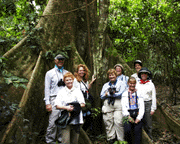 We
all dressed up in our jungle walk clothes; long pants, long sleeve shirts,
boots, socks, floppy hats held on by string, and mosquito nets. We looked
like a bunch of aliens. How the locals must laugh. The rainforest is
big, dense and intimidating. How would we ever find our way without
a guide? Its virgin trees are immense and the lianas are huge. I was
impressed with the amount of growth under the canopy. We were not bothered
by the bugs and the paraphernalia soon came off as we relaxed a bit.
We were in awe of the pretty flowers, the big "Jurassic" tree roots,
towering palm trees and the denseness of it all. We pinched ourselves
to think we were in the middle of a rainforest in a national reserve
in Peru. We
all dressed up in our jungle walk clothes; long pants, long sleeve shirts,
boots, socks, floppy hats held on by string, and mosquito nets. We looked
like a bunch of aliens. How the locals must laugh. The rainforest is
big, dense and intimidating. How would we ever find our way without
a guide? Its virgin trees are immense and the lianas are huge. I was
impressed with the amount of growth under the canopy. We were not bothered
by the bugs and the paraphernalia soon came off as we relaxed a bit.
We were in awe of the pretty flowers, the big "Jurassic" tree roots,
towering palm trees and the denseness of it all. We pinched ourselves
to think we were in the middle of a rainforest in a national reserve
in Peru.
Marty
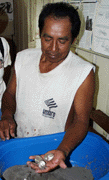 At
about 7:30 this a.m. we got off the Delfin and walked up the logs
embedded in the river bank to get to the ranger station. The first
thing we noticed was a large "sand box". This contained mounds that
covered turtle eggs. The turtle eggs are picked up by the rangers
because the turtles are endangered and the rangers want to prevent
the local people from taking them illegally to eat. The eggs are placed
in the sand mound exactly as they were taken from the original nest.
Their position is determined by the markings left on the eggs when
they are laid in the sand. The eggs take from 60 to 80 days to At
about 7:30 this a.m. we got off the Delfin and walked up the logs
embedded in the river bank to get to the ranger station. The first
thing we noticed was a large "sand box". This contained mounds that
covered turtle eggs. The turtle eggs are picked up by the rangers
because the turtles are endangered and the rangers want to prevent
the local people from taking them illegally to eat. The eggs are placed
in the sand mound exactly as they were taken from the original nest.
Their position is determined by the markings left on the eggs when
they are laid in the sand. The eggs take from 60 to 80 days to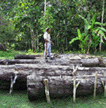 hatch depending upon the temperature. The baby turtles are then taken
to the river and turned loose. Also there were big logs of mahogany
that the rangers had taken from men who had cut the trees illegally
as mahogany is a protected species here.
hatch depending upon the temperature. The baby turtles are then taken
to the river and turned loose. Also there were big logs of mahogany
that the rangers had taken from men who had cut the trees illegally
as mahogany is a protected species here.
Pat
We leave the clearing of the Ranger Station #2 and walk into a curtain
of green that appears to be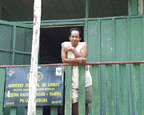 impenetrable. The ground is still soft and damp form the receding water
-- the air inside the green curtain, slightly cool with a slight musty
smell -- the greenery surrounds us and towers above us.
impenetrable. The ground is still soft and damp form the receding water
-- the air inside the green curtain, slightly cool with a slight musty
smell -- the greenery surrounds us and towers above us.
Sally
Dolphin Watching
This morning we went out on the skiff to survey dolphins and
take environmental measurements. Right after breakfast, Tamara gave
us a brief description of the instruments we were going to use. Then,
four of us went out: Tamara, Shelly, Susan and me. Our boat driver was
Fernando. As we were leaving, it started raining very hard. It did not
stop us, for our leader, Tamara, is very persistent and will not let
anything, including weather, stop her or us. Tracy was filming us as
we left like this, "was the last time we saw them in their latest, elegant
rainy jungle gear."
Every ten minutes we stopped and recorded position, time, and environmental
factors. Susan did a great job keeping the notation sheet under her
poncho as she totally covered herself, except her ears, to write the
readings. Tamara and Shelly scanned the river for dolphins, took the
various environmental readings and I was just there day dreaming!!
No, no, NOT! I was in charge of measuring the clarity of the water
with a fanny-looking black and white disk tied to a rope as well as
reading the GPS.
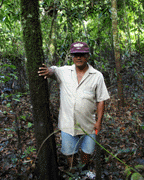 We
moved on to another location and repeated the process; counting dolphins
and taking measurements. Then, we just stopped and turned the motor
off. There was a concert -- the jungle concert -- all around us. The
different sounds harmonized with the river's song, and WE WERE THERE;
four women and one man in a VERY special situation, sitting on a skiff
in the middle of the Amazon River one rainy and very pleasant morning.
(Did I mention that the rain stopped?) What a life! We heard howler
monkeys howling in the nearby trees while the dolphins swam under
the boat gently rocking us. We could see the high water markings on
all of the trees (which are shoulder high on Fernando) and couldn't
believe how much water there was a few months ago. We were having
such a good time that we were late for lunch. Our wonderful crew and
co-travelers patiently waited for us. What a sharing -- blessed group!
This was a one-of-a-kind experience. We
moved on to another location and repeated the process; counting dolphins
and taking measurements. Then, we just stopped and turned the motor
off. There was a concert -- the jungle concert -- all around us. The
different sounds harmonized with the river's song, and WE WERE THERE;
four women and one man in a VERY special situation, sitting on a skiff
in the middle of the Amazon River one rainy and very pleasant morning.
(Did I mention that the rain stopped?) What a life! We heard howler
monkeys howling in the nearby trees while the dolphins swam under
the boat gently rocking us. We could see the high water markings on
all of the trees (which are shoulder high on Fernando) and couldn't
believe how much water there was a few months ago. We were having
such a good time that we were late for lunch. Our wonderful crew and
co-travelers patiently waited for us. What a sharing -- blessed group!
This was a one-of-a-kind experience.
Lilia
P.S. We also saw two caimans swimming in the river. We decided NOT
to swim in this area today.
|





